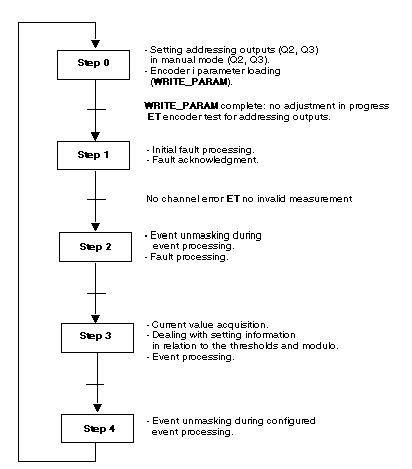Each channel of the TSX CTY 2C module is used to acquire the signals supplied by an absolute encoder with parallel outputs, via a series frame, using adaptation TELEFAST ABE-7CPA11. Use of several TELEFASTs enables up to 4 absolute encoders with parallel outputs to be multiplexed on the same channel.
Multiplexing is managed by the counting application.
Principals of multiplexing
The encoders are addressed by two discrete outputs (belonging to the TSX CTY 2C module, preferably Q2 and Q3 outputs, or to a discrete module). These outputs are looped onto the dedicated TELEFAST inputs. This sends the acquisition value and the address of the present encoder to the TSX CTY 2C module.
The context linked to the encoder (offset value, threshold values, SET and RESET values of the switches), which must change when a new encoder is addressed, is controlled by the application program.
Furthermore, this must take into account the fact that the information regarding position/crossing of thresholds, rollover, the speed value and the overspeed fault is invalid when an encoder is being changed.
This operation involves the following steps for each absolute encoder and at each acquisition:
|
Step
|
Action
|
|
1
|
Application loading of the context for the encoder concerned.
|
|
2
|
Application addressing of the encoder concerned.
|
|
3
|
Acquisition of data.
|
|
4
|
Possible wait linked to the acquisition period, then return to step 1 to process the next encoder.
|
The diagram below shows an example of how to program multiplexing:
